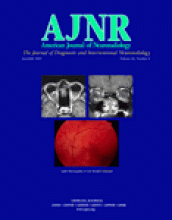Abstract
BACKGROUND AND PURPOSE: A persistent foramen tympanicum, or foramen of Huschke, is an anatomic variation of the tympanic portion of the temporal bone due to a defect in normal ossification in the first 5 years of life. The foramen is located at the anteroinferior aspect of the external auditory canal (EAC), posteromedial to the temporomandibular joint (TMJ). We sought to define its prevalence, location, and size on high-resolution spiral CT (HRCT).
METHODS: We prospectively examined 102 consecutive HRCT studies of the temporal bone (204 ears). HRCT was performed by using 120 kV, 400 mAs, an ultra–high-resolution filter, 0.6-mm section thickness, 0.3-mm section increment, 728 × 728 matrix, and 160-mm field of view. We noted the size and location of the foramen tympanicum relative to the tympanic membrane and calculated its prevalence. Patients with focally decreased tympanic bone thickness of <1 mm at the anteroinferior EAC (between the 3- and 6-o’clock positions) were considered separately.
RESULTS: We found a foramen tympanicum was found in six (4.6%) of 130 ears. Mean axial diameter was 4.2 mm, and mean sagittal diameter was 3.6 mm. Focally reduced bone thickness in the same location was found in 45 (35%) ears, with a female preponderance (P = .003).
CONCLUSION: HRCT is sensitive for detection of the foramen tympanicum because of its thin sections, high spatial resolution, and multiplanar capabilities. Awareness of this anatomic entity may be useful in evaluating patients with transient otorrhea in whom no otologic cause (e.g., ear infection, TMJ disease) is identified.
- Copyright © American Society of Neuroradiology












